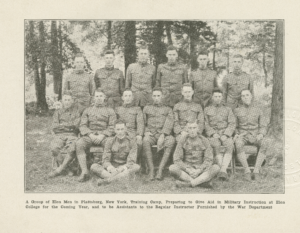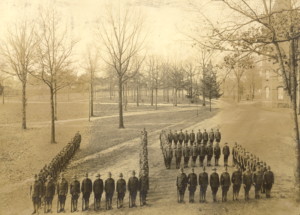Elon College and the First World War, part 3: The SATC at Elon, 1918-1919
By Randall Bowman, Archivist and Assistant Librarian.
In May 1918, the War Department formed the Student Army Training Corps (SATC). Similar in many ways to the Reserve Officers’ Training Corps (ROTC), the SATC was created to encourage young men to attend college and receive military training at the same time. Unlike ROTC, however, SATC members were not training to become commissioned officers. Elon College became one of twelve colleges in North Carolina to qualify for a SATC unit; the Board of Trustees overwhelmingly approved plans to host the company, and the college administration began working with the War Department to prepare Elon to receive the unit for the fall semester 1918.
As part of this preparation, a group of Elon students were chosen to attend a school for military instructors in Plattsburgh, New York, during the summer months of 1918. A photograph published in the August 1918 issue of the Bulletin of Elon College shows the fifteen Elon students who went to Plattsburgh posing for a group picture.

At the start of the fall semester of 1918, Elon College was ravaged by the Spanish Influenza epidemic, along with the rest of the nation and world. When the epidemic finally eased at Elon, the SATC induction ceremony took place on October 5, 1918. With that, Elon College took on the look of an army camp, with soldiers in uniform doing calisthenics and drilling with rifles early each morning before going to class.

SATC troops in formation at Elon spelling “U.S.”, 1918
In March 1953, Elon alumnus Worth Bacon, then the managing editor of the Winston-Salem Journal, wrote a remembrance of his days as a member of the SATC company for the Elon College newspaper, The Maroon and Gold. Mr. Bacon was 18 in 1918, and having registered with the Selective Service, was expecting to be drafted. But at that point the U.S. Government deferred the induction of 18-year-olds. Anxious to do his part, he learned that he could join the Army’s SATC and train as a soldier while enrolled at a college. He tried to join the SATC unit at State College in Raleigh (now NC State University), but that unit was full. He was told he could try at Elon College, so he traveled from Goldsboro to Elon by train and joined the unit.

Worth Bacon’s article in The Maroon and Gold, March 25, 1953.
Mr. Bacon describes daily life as a member of Elon’s SATC company; as part of a rigid training schedule, the company was awakened every morning at 5 AM, followed by calisthenics (physical training). Following breakfast, the company drilled from 8:00 to 10:00 am, and then members marched to class. The afternoon brought more drill and classes, and two hours were spent each night in the study hall (except on Sundays). One night in every ten, each member of the company walked guard duty.
At one point in his reminiscences, Mr. Bacon comments on some of the language used by the officers and drill instructors towards the troops, and what a shock it was to hear such language on Elon’s campus at that time: “The use of such language on the campus of a Christian institution was not conducive to the best relations between the civil and military leaders at Elon.” But while the military discipline was strict, the author had much praise for the commander of Elon’s SATC unit, Captain F. T. Lord, a West Point graduate. Bacon describes Captain Lord as, “An erect man, with keen blue eyes, and well-versed in military tactics, he was a great disciplinarian. He won the respect of the enlisted men who made up the company’s enlisted personnel.”
When the Spanish Influenza struck Elon, Bacon describes how the old gymnasium was used as a hospital, and how those few students like himself who were fortunate to escape the flu where assigned to hospital duty, nursing the sick for two hours and then being off four hours on an around-the-clock schedule. He also states that although he didn’t remember how many Elon students died from the Spanish Flu, he thought at least a dozen passed. We know today that only three Elon students succumbed to the disease, but in many places, the virus was so deadly it did kill numerous people, many of them healthy young men and women.
Bacon also talks about some of the humorous aspects of military training, such as one day when the company bugler sounded reveille at 2:00 am, rather than the usual 5:00 am. The errant bugler avoided physical harm by claiming his watch was three hours fast. Mr. Bacon said this story reminded him of a song about killing the bugler, which is probably a reference to the 1918 song, “Oh, How I Hate to Get Up in the Morning”. This Irving Berlin song has the chorus, “Someday I’m going to murder the bugler, Someday they’re going to find him dead.”
Bacon goes on to name some members of the Elon SATC company who had gone on to have successful careers in a variety of fields, and that thirty-five years later, the men of his generation were now grandfathers. He concludes his reminiscences by saying, “Yes, we had joys and sorrows in Elon’s S.A.T.C. Those joys and sorrows are now matters of history, but they will linger in the memories of those who shared them.”
Leave a Reply